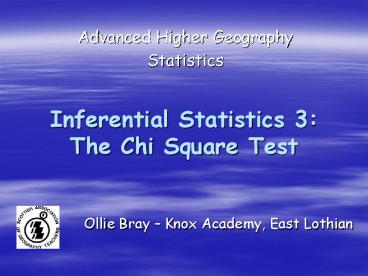Inferential Statistics 3: The Chi Square Test - PowerPoint PPT Presentation
1 / 15
Title:
Inferential Statistics 3: The Chi Square Test
Description:
Advanced Higher Geography Statistics Inferential Statistics 3: The Chi Square Test Ollie Bray Knox Academy, East Lothian Introduction (1) We often have occasions ... – PowerPoint PPT presentation
Number of Views:166
Avg rating:3.0/5.0
Title: Inferential Statistics 3: The Chi Square Test
1
Inferential Statistics 3The Chi Square Test
- Advanced Higher Geography
- Statistics
Ollie Bray Knox Academy, East Lothian
2
Introduction (1)
- We often have occasions to make comparisons
between two characteristics of something to see
if they are linked or related to each other. - One way to do this is to work out what we would
expect to find if there was no relationship
between them (the usual null hypothesis) and what
we actually observe.
3
Introduction (2)
- The test we use to measure the differences
between what is observed and what is expected
according to an assumed hypothesis is called the
chi-square test.
4
For Example
- Some null hypotheses may be
- there is no relationship between the height of
the land and the vegetation cover. - there is no difference in the location of
superstores and small grocers shops - there is no connection between the size of farm
and the type of farm
5
Important
- The chi square test can only be used on data that
has the following characteristics
The frequency data must have a precise numerical
value and must be organised into categories or
groups.
The data must be in the form of frequencies
The expected frequency in any one cell of the
table must be greater than 5.
The total number of observations must be greater
than 20.
6
Formula
?2 The value of chi square O The observed
value E The expected value ? (O E)2 all the
values of (O E) squared then added together
7
Worked Example
- Write down the NULL HYPOTHESIS and ALTERNATIVE
HYPOTHESIS and set the LEVEL OF SIGNIFICANCE. - NH there is no difference in the distribution
of old established industries and food processing
industries in the postal district of Leicester - AH There is a difference in the distribution of
old established industries and food processing
industries in the postal district of Leicester - We will set the level of significance at 0.05.
8
Table Time!
Construct a table with the information you have
observed or obtained.
Observed Frequencies (O)
(Note that although there are 3 cells in the
table that are not greater than 5, these are
observed frequencies. It is only the expected
frequencies that have to be greater than 5.)
9
Now
- Work out the expected frequency.
Eg expected frequency for old industry in LE1
(50 x 13) / 92 7.07
10
Check your answers
11
Now
- For each of the cells calculate.
Eg Old industry in LE1 is (9 7.07)2 / 7.07
0.53
12
Check your answers
Then
Add up all of the above numbers to obtain the
value for chi square ?2 15.14.
13
Finally
- Look up the significance tables. These will tell
you whether to accept the null hypothesis or
reject it.
The number of degrees of freedom to use is the
number of rows in the table minus 1, multiplied
by the number of columns minus 1. This is (2-1) x
(5-1) 1 x 4 4 degrees of freedom. We find
that our answer of 15.14 is greater than the
critical value of 9.49 (for 4 degrees of freedom
and a significance level of 0.05) and so we
reject the null hypothesis.
14
In other words
The distribution of old established industry and
food processing industries in Leicester is
significantly different.
The hard bit!
Now you have to look for geographical factors to
explain your findings
15
Your Turn
- Read page 46, 47 and 48 of Geographical
Measurements and Techniques Statistical
Awareness, by LT Scotland, June 2000. - Answer Task 1 on page 48.































